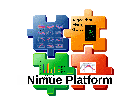Inhaltsverzeichnis
Conventional Gait Model
Introduction
The conventional gait model has many variations. The defacto standard is its implementation from Vicon and called Vicon Plug In Gait model (PiG).
This includes the following angles:
| ANGLES | POSITIVE ROTATION | AXIS | DIRECTION | ANGLES | POSITIVE ROTATION | AXIS | DIRECTION | ||
|---|---|---|---|---|---|---|---|---|---|
| LPelvisAngles | 1 | Anterior Tilt | Prg.Fm. Y | Anti-clockwise | RPelvisAngles | 1 | Anterior Tilt | Prg.Fm. Y | Anti-clockwise |
| LPelvisAngles | 2 | Upward Obliquity | Prg.Fm. X’ | Anti-clockwise | 2 | Upward Obliquity | Prg.Fm. X’ | Clockwise | |
| LPelvisAngles | 3 | Internal Rotation | Prg.Fm. Z’’ | Clockwise | 3 | Internal Rotation | Prg.Fm. Z’’ | Anti-clockwise | |
| LFootProgressAngles | 1 | - | Prg.Fm. Y | - | RFootProgressAngles | 1 | - | Prg.Fm. Y | - |
| LFootProgressAngles | 2 | - | Prg.Fm. X’ | - | RFootProgressAngles | 2 | - | Prg.Fm. X’ | - |
| LFootProgressAngles | 3 | Internal Rotation | Prg.Fm. Z’’ | Clockwise | RFootProgressAngles | 3 | Internal Rotation | Prg.Fm. Z’’ | Anti-clockwise |
| LHipAngles | 1 | Flexion | Pelvis Y | Clockwise | RHipAngles | 1 | Flexion | Pelvis Y | Clockwise |
| LHipAngles | 2 | Adduction | Pelvis X’ | Clockwise | RHipAngles | 2 | Adduction | Pelvis X’ | Anti-clockwise |
| LHipAngles | 3 | Internal Rotation | Pelvis Z’’ | Clockwise | RHipAngles | 3 | Internal Rotation | Pelvis Z’’ | Anti-clockwise |
| LKneeAngles | 1 | Flexion | Thigh Y | Anti-clockwise | RKneeAngles | 1 | Flexion | Thigh Y | Anti-clockwise |
| LKneeAngles | 2 | Varus/Adduction | Thigh X’ | Clockwise | RKneeAngles | 2 | Varus/Adduction | Thigh X’ | Anti-clockwise |
| LKneeAngles | 3 | Internal Rotation | Thigh Z’’ | Clockwise | RKneeAngles | 3 | Internal Rotation | Thigh Z’’ | Anti-clockwise |
| LAnkleAngles | 1 | Dorsiflexion | Tibia Y | Clockwise | RAnkleAngles | 1 | Dorsiflexion | Tibia Y | Clockwise |
| LAnkleAngles | 2 | Inversion/ Adduction | Tibia X’’ | Clockwise | RAnkleAngles | 2 | Inversion/ Adduction | Tibia X’’ | Anti-clockwise |
| LAnkleAngles | 3 | Internal Rotation | Tibia Z’ | Clockwise | RAnkleAngles | 3 | Internal Rotation | Tibia Z’ | Anti-clockwise |
References
These references have information on kinematic and kinectic calculations, as well as anthropometrics and repeatability of the model. The Vicon upper body model has not been validated in any peer reviewed journal papers and therefore there are no articles on repeatability of the upper body model.
Bell AL, Pedersen DR, Brand RA
J Biomech23p617-21(1990)
Davis, R., Ounpuu, S., Tyburski, D. & Gage, J. (1991). A gait analysis data collection and reduction technique. Human Movement Sciences, 10, 575-587.
Kadaba, M.P., Ramakrishnan, H.K. & Wooten, M.E. (1987). J.L. Stein, ed. Lower extremity joint moments and ground reaction torque in adult gait. Biomechanics of Normal and Prosthetic Gait. BED Vol (4)/DSC Vol 7. American Society of Mechanical Engineers. 87-92.
Kadaba MP, Ramakrishnan HK, Wootten ME, Gainey J, Gorton G, Cochran GV
J Orthop Res7p849-60(1989)
Kadaba MP, Ramakrishnan HK, Wootten ME
J Orthop Res8p383-92(1990 May)
Macleod, A. And Morris, J.R.W. (1987). Investigation of inherent experimental noise in kinematic experiments using superficial markers. Biomechanics X-B, Human Kinetics Publishers, Inc., Chicago, 1035-1039.
Ramakrishnan HK, Kadaba MP
J Biomech24p969-77(1991)
Ramakrishnan, H.K., Masiello G. & kadaba M.P. (1991). On the estimation of the three dimensional joint moments in gait. 1991 Biomechanics Symposium, ASME 1991, 120, 333-339.
Sutherland, D.H. (1984). Gait Disorders in Childhood and Adolescence. Williams and Wilkins, Baltimore.
Winter DA
Crit Rev Biomed Eng9p287-314(1984)
